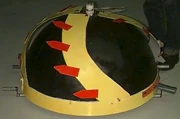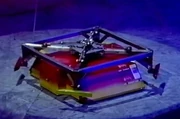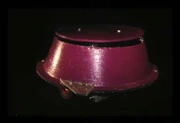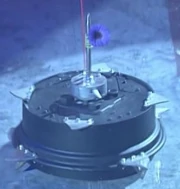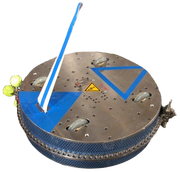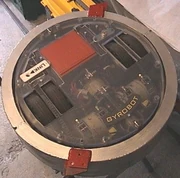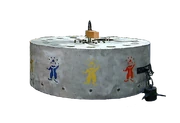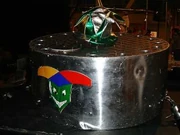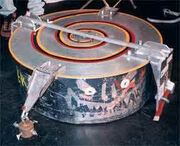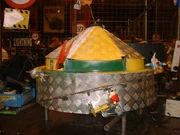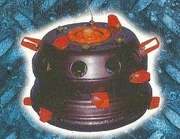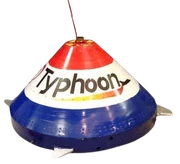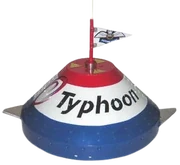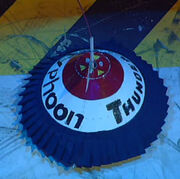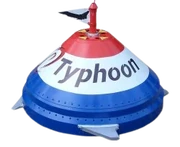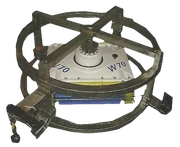A full-body spinner (also simply body spinner), is a spinning weapon which encompasses the robot's body in any shape or form. There have been several kinds of full-body spinner in Robot Wars, ranging in levels of destructive capability and success.
A number of full-body spinner designs were first pioneered in the 1994-1997 US competitions, including the overhead subtype introduced by Mauler's heavyweight incarnations. Among the most notable and destructive was the first shell spinner, Blendo, whose weapon proved powerful enough for it to be withdrawn due to safety concerns. In exchange for the forfeits - caused by it sending debris out of arena boundaries - Blendo earnt co-champion status in the 1995 and 1997 Heavyweight Face-Off championships, plus the 1997 Heavyweight Melee tournament.[1][2][3]
The first example to be seen in the televised series was the 'spinning dome' of Caliban in Series 2, although it was interchangeable with a set of flails and was never seen in action. It would not be until Series 4 when a full-body spinner would get to fight in the UK show, in the form of War Hog. By far the most successful full-body spinners from televised series are the robots of Team Typhoon - including multiple Middleweight champions Typhoon and Series 7 champion Typhoon 2 - and Extreme Warriors Season 1 runner-up The Revolutionist.
Definition[]
A Full-body spinner describes a horizontal spinning weapon which surrounds part of or all of a robot's chassis and internals, providing 360 degrees of attack. These weapons often rotate on a central shaft, or on a mechanism between the weapon and chassis, and are lined with blades, flails, teeth or other sharp/weighted weapons in order to cause damage to other robots. A full-body spinner, as its name implies, covers the entire body of a robot using a spinning weapon.
There exist two primary variations of the full-body spinner concept:
- Ring spinner - Alternatively named rim spinners, these consist of an individual, circularly-shaped disc or blade, surrounding the exterior and spinning independently of the robot's main chassis. Examples include M.R. Speed Squared and Gyrobot.
- Shell spinner - A design whereby the spinner is the robot's own armour, and the whole exterior of the robot is used as a spinning weapon. Examples include Typhoon 2 and the original Corkscrew.
While not truly meeting either definition, top-mounted spinners with a 360-degree reach, such as those of Mauler and Bloody Murder Weapon, are also included here.
Advantages and Disadvantages[]
Advantages

Sir Killalot exercises caution against the spinning War Hog
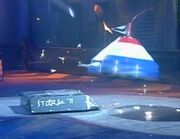
Typhoon 2 launches upon deflecting Storm 2's charge, as a result of its gyroscopic speeds
- This weapon protects the robot on all sides, making it virtually impossible to approach the robot without some kind of spinner contact being made in the process.
- As with all heavy spinners, the damage output of full-body spinners is very high when executed well. This is best demonstrated by the machines of Team Typhoon, especially Typhoon 2, which was able to cause substantial amounts of damage to other competitors and the arena wall throughout its Series 7 run.
- The gyroscopic forces acting on the robot when the weapon spins up makes it difficult for the robot to be flipped over by an opponent. This was crucial in allowing Typhoon 2 to remain upright in its Series 7 Grand Final as Storm 2 got underneath it with its front wedge.
- Ring spinners can also be compatible with invertible designs, as proven by Gyrobot and M.R. Speed Squared.
- By working independently of a robot's locomotion to offer free movement, the full body spinner succeeds the sit-and-spin design.
- Shell spinners can circumvent the issue of most spinners where their weapon's heavy weight prevents them from having thicker armour. Instead, the shell provides both the robot's weapon and armour, allowing it to be very thick and resilient to offer optimal protection.
- Depending on the design, both sub-types are capable of accommodating interchangeable weapon configurations to suit different opponents or event requirements. For example, pioneer Caliban could exchange its 'dome' for top-mounted flails, while the rim of the Series 8 M.R. Speed Squared was officially stated to have a range of optional attachments, including weights and spikes.
Disadvantages

Delldog pushes Dynamite towards a CPZ
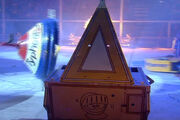
Typhoon 2 is flipped by Raging Reality after being unable to get its weapon up to speed

The flat top armour of The Revolutionist left it vulnerable to crushing and lifting attacks from Razer
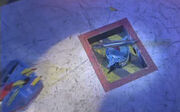
Corkscrew ricochets into the pit after an attack on Kronic 2

M.R. Speed Squared takes flight
- Being mostly circular-shaped, robots with full-body spinners usually suffer from poor pushing ability as a result of their shape, and generally struggle to fight if the weapon were to stop spinning. Only The Revolutionist, Delldog, Corkscrew and Typhoon proved successful in ramming and pushing other opponents to victory. M.R. Speed Squared and Corkscrew Two both had to fight without the use of their weapons on occasions; the former only managed to win one battle with its ring spinner not functioning at all.
- They take time to spin up as with all other spinning weapons, which leaves robots with them particularly vulnerable to flippers if they are unable to avoid them or get their weapons up to speed in time. This was crucial in Ripper's three-second defeat of Daisy-Cutter, which was able to get underneath Daisy-Cutter and defeat it before it was able to spin its weapon up.
- Designs featuring flat top armour are still vulnerable to attacks from overhead or crushing weapons. Both ring/rim and shell sub-types have exhibited this weakness, including M.R. Speed Squared against Thor's axe in Series 8, and The Revolutionist against Razer in The Second World Championship.
- It is often difficult to incorporate an effective and reliable self-righting mechanism into a full-body spinner; there were no instances in Robot Wars of a shell spinner featuring one. Of the rim/ring spinners, which were mostly invertible anyway, only Revenge of Trouble & Strife was able to feature a self-righting mechanism through its pneumatic flipping arm, although this often failed to work throughout its appearances.
- Additionally, it is impossible for shell spinners to be compatible with an invertible design.
- As with other heavy spinners, the build-up of kinetic energy in a full-body spinner could cause it to recoil. Besides causing internal damage, the recoil from a full-body spinner could also cause the robot to rebound in a different direction, potentially into arena hazards. Most notably, Corkscrew was eliminated from its Series 6 melee after rebounding into the the pit following an attack on Kronic 2, while Typhoon Lightning (as one part of Typhoon Twins), also ricocheted into the pit against 259 in the Extreme 2 Middleweight Championship.
- When badly damaged, full-body spinners can create stability issues for the robot - usually through gyro or weight imbalance - or increase the friction running through the machine. The Series 9 version of M.R. Speed Squared often struggled to remain on the floor once the recoil of its hits knocked the robot off-balance; during its Head-to-Head against Concussion, it even threw itself off the arena floor while trying to spin itself and its weapon up at the same time.
- Shell spinners are generally symmetrical, with little indication of where the front of the robot is pointing once the shell has started spinning. This can often make robots of this type difficult to control, a factor somewhat mitigated by static devices fitted to the top of the weapon shaft (e.g. the flags on later Team Typhoon machines).
- Depending on the weapon's destructive potential, they often raised safety concerns with the Robot Wars production crew during the show's original run. Warhog and Typhoon 2 both shattered the arena wall at various points during their UK Series campaigns. Prior to this, The Mauler was disqualified from The First World Championship altogether, when the producers deemed that its weapon was too powerful for the arena to contain safely. Similar circumstances also lead to Blendo forfeiting partway through its 1995 and 1997 Face-Off runs.
List of Full Body Spinners[]
Robots are listed alphabetically.
DESKTOP MODE ONLY: Robots which are not heavyweight entries are listed with a green background. Robots from the 1994-1997 US competitions are listed with a purple background.
| Robot | Sub-Type | Series Appearances with Full Body Spinners | Notes | Image |
|---|---|---|---|---|
| Banshee | Rim | Series 4 | Top speed of 200rpm. | |
| Beaverbot | Shell | Dutch Series 2 | Dome-shaped shell with several spikes. | |
| Blendo | Shell | 1995 & 1997 US Championships | Industrial mild steel cooking wok, attached to a full-width steel flywheel with interchangeable cutting blades/teeth. Powered by a 5hp Briggs & Stratton engine. Forfeited both competitions due to safety issues in Face-Off battles. 1995 and 1997 Heavyweight Face-Off Co-Champion; 1997 Heavyweight Melee Co-Champion; winner of 'Best Engineering' award in 1995 (alongside Thor) and 1997.[4][1][5][6][7][8] | |
| Bloody Murder Weapon | Overhead | Dutch Series 2 | Weapon consisted of an overhead spinning frame with four spiked blades attached to the ends. Failed to work in either of the robot's battles. | |
| Caliban | Overhead/shell | Series 2 | First UK Series robot with a full-body spinner, featuring two cutting blades at the base and quoted on the Team TFOSICA website as being made from a 40kg wok.[9] Rotated at 200prm. Unused in combat as the robot was eliminated at the Gauntlet stage. Interchangeable with top-mounted spinning flails. | |
| Corkscrew | Shell (original) Ring/rim (Series 7) |
Series 5-7, Extreme 2 | The original Corkscrew was a shell spinner with a weapon and body made out of a lorry wheel, lined with large cutting blades. Its successor, Corkscrew Two, was an invertible ring spinner with a weapon speed of 1,000rpm, which ultimately failed to spin up its weapon in battle. | |
| Cyclone (Dutch) | Shell | Dutch Series 2 | Weapon failed to work in both its battles. | |
| Daisy-Cutter | Shell | Series 7 | Made out of half a tractor wheel. | |
| Delldog | Ring/rim | Series 6, German Series | Spinning rim weighed 25kg and spun at 1,000rpm. | |
| Gyrobot | Rim | Series 7 | Weapon weighed 35kg and spun at 750rpm, increasing to 1,500rpm when the robot spun on the spot. | |
| Humdrum | Shell | Nickelodeon | Loanerbot. Equipped with two swinging maces, each attached to the shell with chains. Also entered Extreme Warriors Season 1 as Joker. | |
| Joker | Shell | US Season 1 | Loanerbot. Equipped with two swinging maces, each attached to the shell with chains. Was leant to the Sylvan Lake Robot Warriors for Extreme Warriors Season 1 after their original version of Joker got lost in transit. Later entered Nickelodeon Robot Wars as Humdrum. | |
| Mauler | Overhead | 1995-1997 US Championships, Series 3, MTV Pilot |
Top-mounted aluminum[10] disc with chain flails and/or chisels which swung out at full speed. 1996 Heavyweight Melee Finalist as South Bay Mauler;[11][12] 1997 Heavyweight Face-Off Semi-Finalist[13][14][15] and winner of the unaired American Robot Wars 2000 pilot. Disqualified from The First World Championship as the producers deemed it unsafe for the arena to contain. Heavyweight versions also competed under the names Mauler 95[16] (1995), The Mauler and Mauler 2000.[16] |
|
| M.R. Speed Squared | Rim/ring | Series 8-9 | Two-toothed rim weapon weighed 22kg and spun at a force of 80 kilojoules in Series 8, with a rotational speed of 1,000rpm and optional weight or spike attachments. Series 9 version armed with a 10mm HARDOX ring, weighing 35kg and spinning at 900rpm. | |
| Night Stalker | Shell | US Season 2 | Weapon rotated with a top speed of 1,000rpm, but failed to spin in battle. | |
| Revenge of Trouble & Strife | Rim | Series 6-7, Extreme 2 | Weapon weighed 25kg and spun up to 500rpm. Only Robot Wars competitor to combine a full-body spinner with a srimech, through its pneumatic flipping arm. | |
| Scarey-Go-Round | Shell | Series 7 | Assortment of cutting blades and soft toy 'riders' suspended from the spinning lower ring, themed around a merry-go-round. | |
| Spin Doctor | Shell | Series 6-7, Extreme 2 | Made out of a lorry wheel. | |
| The Revolutionist | Shell | US Season 1-2, Nickelodeon | Low cylindrical body lined with several steel cutting teeth. Runner-up in Extreme Warriors Season 1. | 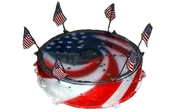 The Revolutionist in US Season 1 |
| Typhoon | Shell | Series 7, Extreme 1-2 | Conical body with four cutting blades. Extreme 1-2 and Series 7 Middleweight Champion. | |
| Typhoon Cadet | Shell | Series 7 | Team Typhoon featherweight. Conical body with two cutting blades. | |
| Typhoon Thunder | Shell | Extreme 2 | Conical body with a fabric skirt concealing the cutting blades. Extreme 2 Lightweight Champion. | |
| Typhoon Twins | Shell | Extreme 2 | Two lightweight robots - Typhoon Thunder and Typhoon Lightning - joined together to form a clusterbot. Extreme 2 Middleweight Championship finalist. | |
| Typhoon 2 | Shell | Series 7, Extreme 2 | Conical body with four cutting blades and petrol power. Series 7 Champion. | |
| U.R.O. | Ring/rim | Series 7 | Ring spinner weighed only 2.5kg, designed more to cut than deal heavy blows. | |
| Warhog | Rim | Series 4-6 | Low-mounted 30kg rim spinning at up to 500rpm. First to fight a televised battle with this weapon sub-type, then initially named War Hog. | |
| Whirlpool 70 | Overhead | Extreme 1, US Season 1 | Built out of a swimming pool cleaning device. Interchangeable maces, spikes and hooks. |
References[]
- ↑ 1.0 1.1 'BLENDO', Team Spike website (archived)
- ↑ Brad Stone (2003), Gearheads: The Turbulent Rise of Robotic Sports, pp.56-60, pp.106-107
- ↑ 'Robot Wars 1997 bonus video: Blendo withdrawing from the competition', Andrew Lindsey (YouTube), uploaded May 8 2021
- ↑ 'Robot Wars 1997 Interview: Jamie Hyneman with Blendo', Andrew Lindsey (YouTube), uploaded April 26 2021
- ↑ 'How Lethal Was Blendo REALLY?', Adam Savage's Tested (YouTube), uploaded July 15 2023
- ↑ 'Jamie Hyneman on Killer Death Robots and Robot Bloodsport', Adam Savage's Tested (YouTube), uploaded July 17 2013
- ↑ 'ROBOT WARS ® Photos -- 1995 Winners', US Robot Wars website (archived May 2 1997)
- ↑ 'Robot Wars 1997 Winners', US Robot Wars website (archived December 5 1998)
- ↑ http://web.archive.org/web/20000615053922/http://members.xoom.com/Chunkymonky/rwar/stable/caliban.htm
- ↑ 'THE MAULER', Team Spike website (archived)
- ↑ 'Robot Wars 1996 - Heavyweight Melee 5', diabolicalmachine (YouTube), uploaded October 28 2008
- ↑ 'Robot Wars 1996: Heavyweight Melee 5', Andrew Lindsey (YouTube), uploaded January 15 2019
- ↑ 'Robot Wars 1997 Heavyweight match: The South Bay Mauler versus Biohazard', Andrew Lindsey (YouTube), uploaded May 9 2021
- ↑ 'MATCH: BIOHAZARD VS THE MAULER' (archived)
- ↑ 'Robot Battles', Robotbooks/BioHazard website (archived March 31 2001)
- ↑ 16.0 16.1 'Maulers of Old', Team Mauler website (archived)
[]
| ||||||||||||||||||||||||||||||||


